Stop Waking Up to Your iPhone Alarm
Cool alarm clocks for collectors—a guide for the design-obsessed.
For paid subscribers: I’m having a live chat + Q&A with friend Max Braun, co-host of the Hairspring Watches podcast, on May 30 at 3pm ET. Watch for the livestream link in your inbox. We’ll do a vintage market update, take listener Qs, and have a good time. Upgrade now to join:
8 Cool Ways to Wake Up That Aren’t Your iPhone Alarm
Miles Fisher asks:
I’d be grateful for your guidance on alarm clocks.
I’ve begun a habit that has changed the quality of my life—powering off my mobile phone in the evening, keeping it in another room while I sleep, and only turning it back on after writing for 2 hours in the morning.
I’ve been using an old Braun travel clock. It’s fine enough but on its last legs. I’d like to keep it analogue and don’t want to shell out major $$ (I’ll save that for my wrist). Can you help guide me towards some smartly designed, reliable options? Any heritage options? —January Q&A
According to my Amazon history, I’ve been on the same enlightened no-iPhone alarm regimen as Miles since August 2022:
I’ve also traveled with that Braun alarm clock since 2022. Funny enough, I just lost it in my hotel room at Watches & Wonders last month.
I love this question. iPhone alarms suck. Like Miles, I moved away from mine so I could give myself 30 minutes each morning before getting sucked into the daily vortex known as the modern human condition.
More than that, I love the idea of turning your back on modern technology, if only for a blissful morning, to improve your life. That’s the appeal of vintage watches, after all—anti-tech tech.
Who says it has to stop at wristwatches?
Keep it Simple
My first inclination: Don’t overthink it. Two of the most popular posts of all time over on my favorite subreddit, r/BuyItForLife are simple digital GE alarm clocks from the ‘90s that I certainly remember in my grandparents’ house.
Meanwhile, more than a few people mentioned that they love their Phillips smart alarms, but a light that gradually nudges you awake feels like too much tech for this particular inquiry.
So let’s focus on analog and smartly designed. Like the best watches, these clocks are tools first, but the joy is in their form and the way they anchor a daily ritual.
1/ Digital First: Timex & Casio

Before we go analog, there’s the obvious option: the digital Timex, Casio, or a G-Shock.
Subscriber Ren told me he uses his trusty Timex Ironman to wake up every morning.
“5:30am everyday,” he said, doing his best impression of a Saratoga Springs-soaked morning routine. Like Ren, Mike, the developer behind Pushers.io (not Mike Nouveau), uses his Casio G-Shock alarm every morning.
“I have some cool clocks, but don’t know if I’d trust ‘em to get me and the kids up for school,” he added.
Nothing wrong with a digital wristwatch alarm—pure, functional, always on time. That digital beep isn’t exactly a pleasant AM jolt, but it’s better than most iPhone alarms.
While it technically does the job—keeping us away from the pull of our phones—we can go further than a battery-powered beeper.
2/ The Mechanical Alarm Wristwatch
Even less advanced than the digital Timex or Casio is the mechanical alarm watch: Vulcain Cricket, Jaeger-LeCoultre Memovox, Tudor Advisor, and so on.
They’re fun, and they keep you in the mechanical wristwatch lane.
But they also sound like this, which will make your spouse, pet, and the mice in your floorboard despise you:
It’s also such a pain to fiddle with the little pushers at XX.45am in the morning to “turn that d*mn buzz off, honey!” When I got this Cricket a few years ago, I used it as an alarm all of one time before my cat threatened to leave me, taking my wife with her.
3/ Mechanical Travel Alarm Clock

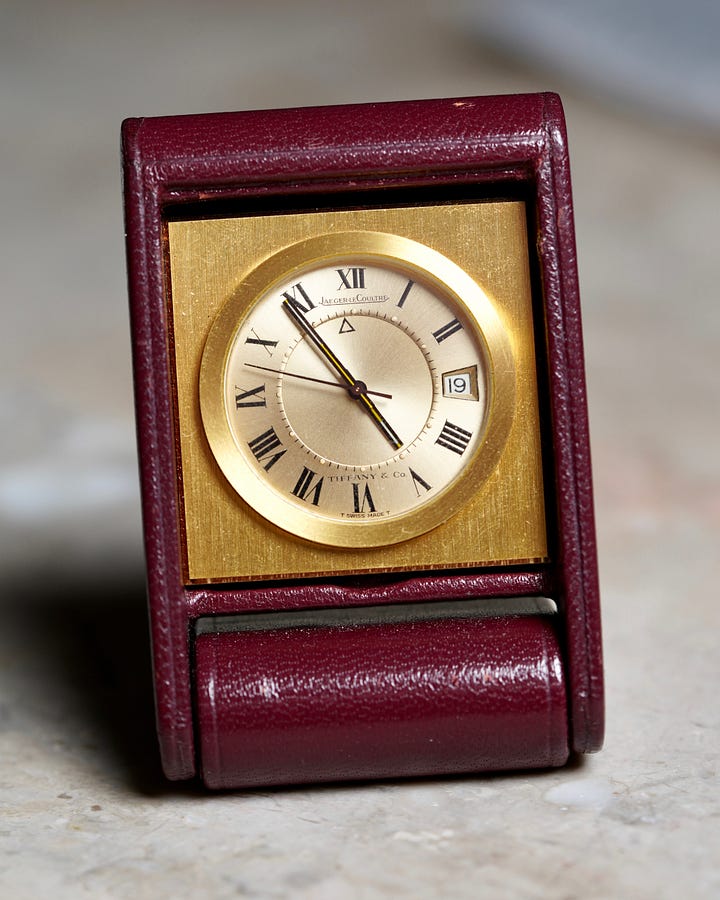
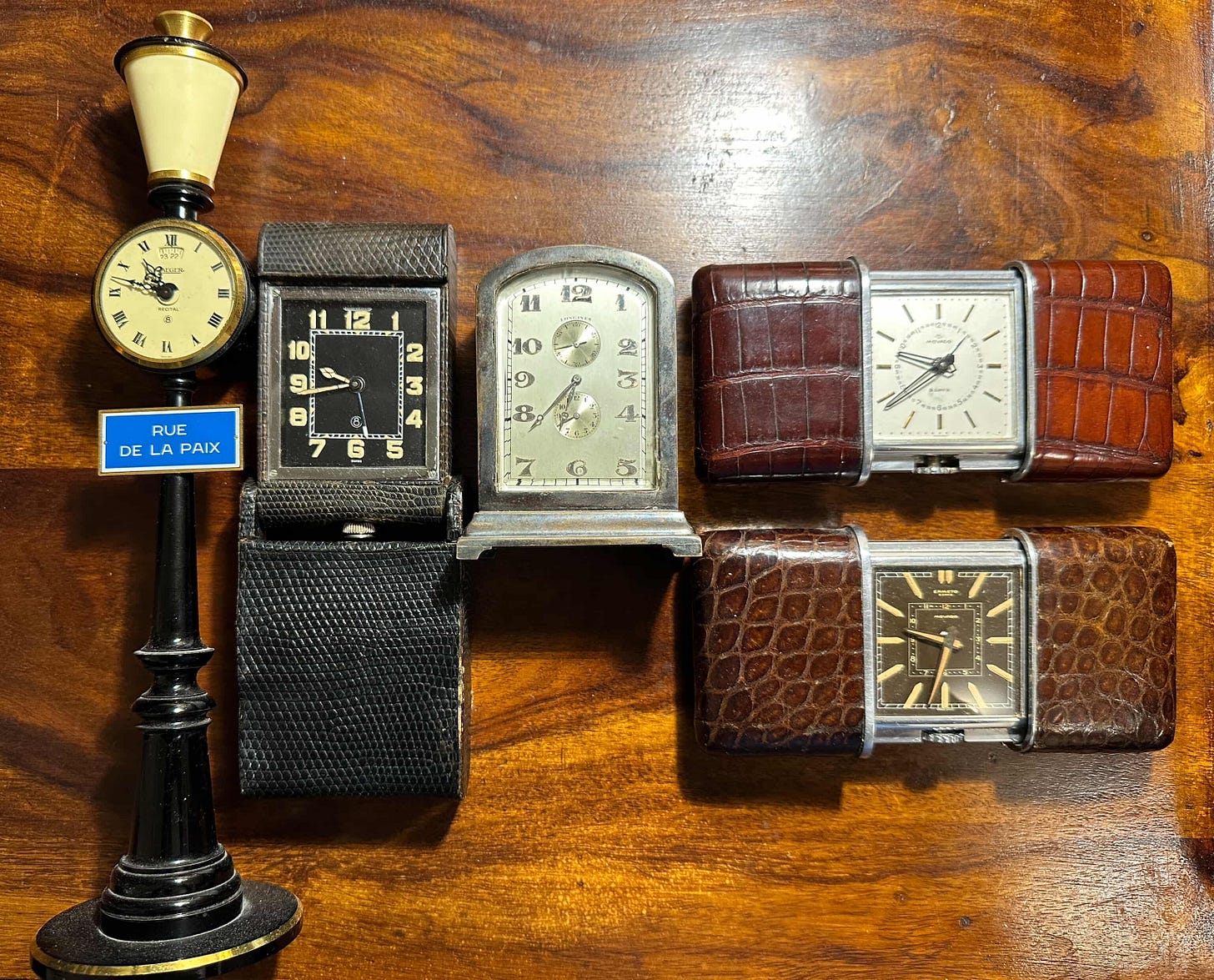
The beefed-up cousin of the mechanical wristwatch alarm is the alarm clock or travel alarm clock.
Function aside: This is a fun, rewarding corner of collecting. Throughout the 20th century, many of the names we know and admire made mechanical alarms. Jaeger-LeCoultre (of course!) made many, which you’ll often find signed for retailers like Cartier, Hermes, or Tiffany & Co. In wristwatches, I don’t care to pay the premium for a retailer signature. But clocks are cheaper, so why not?
They’re excellent decorations for your shelf or desk— a sneaky way to let your hobby seep into more corners of the home without your partner even noticing.
That said. While the alarms can sound slightly better than that Cricket, they can still be jarring. My Jaeger-LeCoultre sounds like an old school bell:
As one travel/alarm clock collector said to me:
“I have something like 200. I use none of them 🙃”
Another collector said he doesn’t use his vintage Hermes alarm clock to wake up, but he uses it throughout the day to set reminders. I like that! Certainly easier to remember than looking down at your chronograph or diving bezel for, wait..what was I timing again?
My Pick. Travel clocks in leather cases by LeCoultre, sometimes co-signed by retailers, are my favorites of the genre. Make sure the leather’s intact and it’ll class up any bookshelf.
Follow the right eBay saved search, and you should be able to scoop one up. A JLC clock will run a few hundred, while retailer-signed examples can easily reach $1,500+. There are small and large sizes; I prefer the larger 8-Day Clocks, referring to their power reserve.
A few eBay finds:
LeCoultre 8-Day Ados Alarm Clock (listed at $700, but I’d target more like ~$500)
Not many great ones right now, so I’ll include a few picks in the next Watchlist.
4/ Braun Clocks
As with most functional objects, we could say Braun and be done with it.
I used that Braun BC02 for years, and it’s just fine. Small, simple, functional, with a light beep that crescendos. The classic BC05 adds the world time map on the lid.
Braun’s first alarm clock was the AB20, introduced in 1971 and designed by Dieter Rams and Dietrich Lubs. Soon after came the AB 30, AB 1, and AB 5, which refined the original with more ergonomic and modern aesthetics.
You can still find originals online. Like a Swatch, prioritize NOS or close to it—you don’t want to miss a meeting and blame your 40-year-old alarm.
Just know these are small, plastic, and don’t feel substantial. But that’s what 20 bucks gets you in 2025.
My pick: Braun BC02 Travel Alarm Clock
5/ The Design-First Alarm Clock
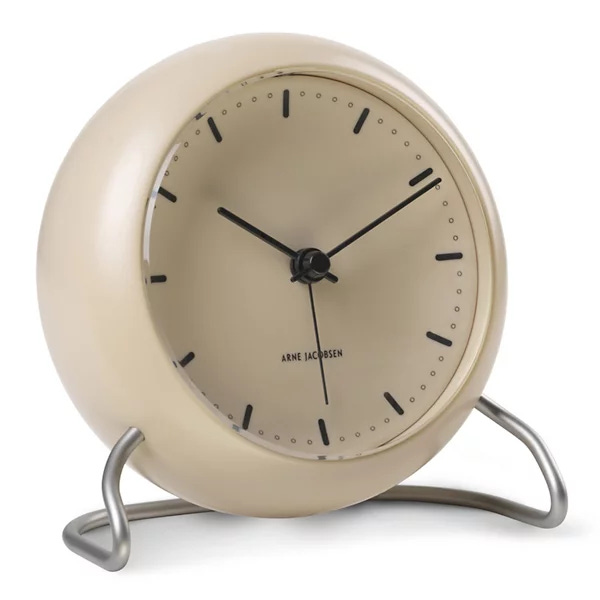

Braun is merely the most well-known of what I’ll call the design-first alarm clock. These are clocks by designers, often made for decades in nearly the same form.
The Arne Jacobsen alarm clock is another. Designed by Danish modernist Arne Jacobsen in the 1930s, it starts from the same minimalist principles as Braun and Rams, but the bowl-shaped body sits on two delicate metal legs, giving it a distinct silhouette. You can find them new (~$140), but why not hunt an old one?
Subscriber Manan (above) told me he found a matching vintage set for him and his wife while antiquing in the Hudson Valley, describing a scene fit for a romcom starring Meg Ryan.
A few other well-designed alarm clocks:
Twemco Alarm Flip Clock, $150
The Flip Clock became popular in the 1950s and 60s; today, Hong Kong’s Twemco is the largest maker of flip clocks. A bit more whimsy than the standard analog clock, the AL-30 Alarm Flip Clock works for a nightstand.
A modern, minimal, and nicely designed alarm clock. Designed by Jasper Morrison, made in Japan.
Lemnos Farbe Alarm Clock, ($99 at Schoolhouse)
A dressed-up take on the Braun alarm, made of beechwood.
Mondaine Swiss Railway Alarm Clock, ~$250
A simple alarm clock from the company that makes clocks for the Swiss railway. A classic design, but I’m not sure I want a train station in my bedroom.
These can be bought new, but have some fun and take the hunt to eBay or a local estate sale. I’ve gone to some estate sales in Gold Coast here in Chicago, and I can tell you: Old rich folks love a fancy designer clock.
6/ Wild West: Vintage Quartz Buzzers
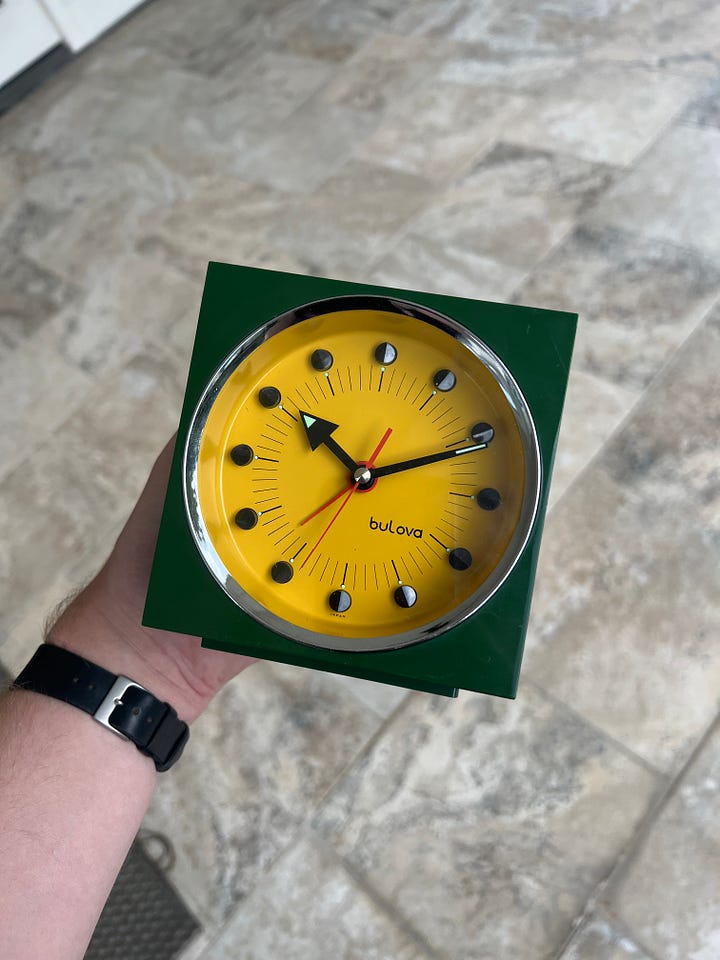
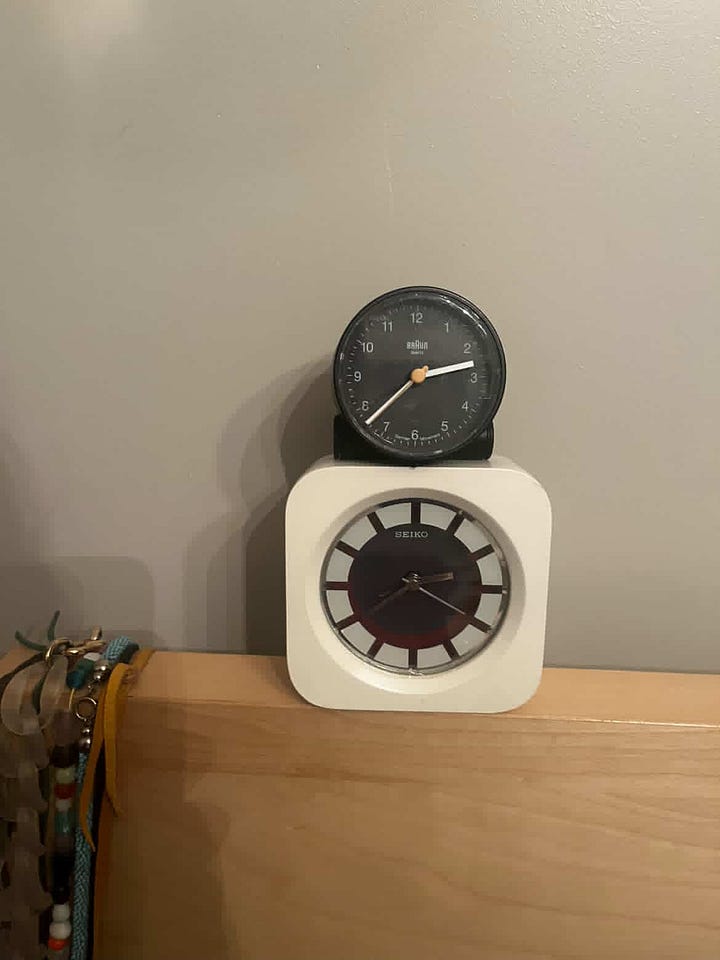
This is the Wild West. Once quartz got cheap, many brands started playing with alarm clocks, which continues to this day.
Plug any old brand + “alarm clock” into eBay and you’ll stumble into something cool. Above, a few examples from subscribers: Bulova and Seiko.
7/ Fancy Collector Clocks
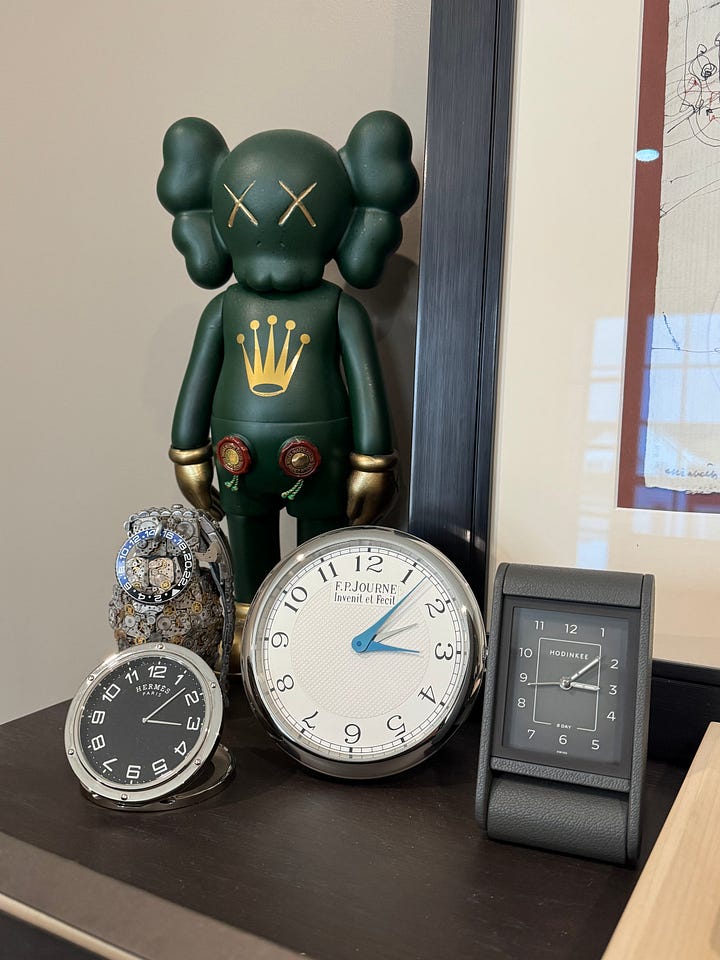
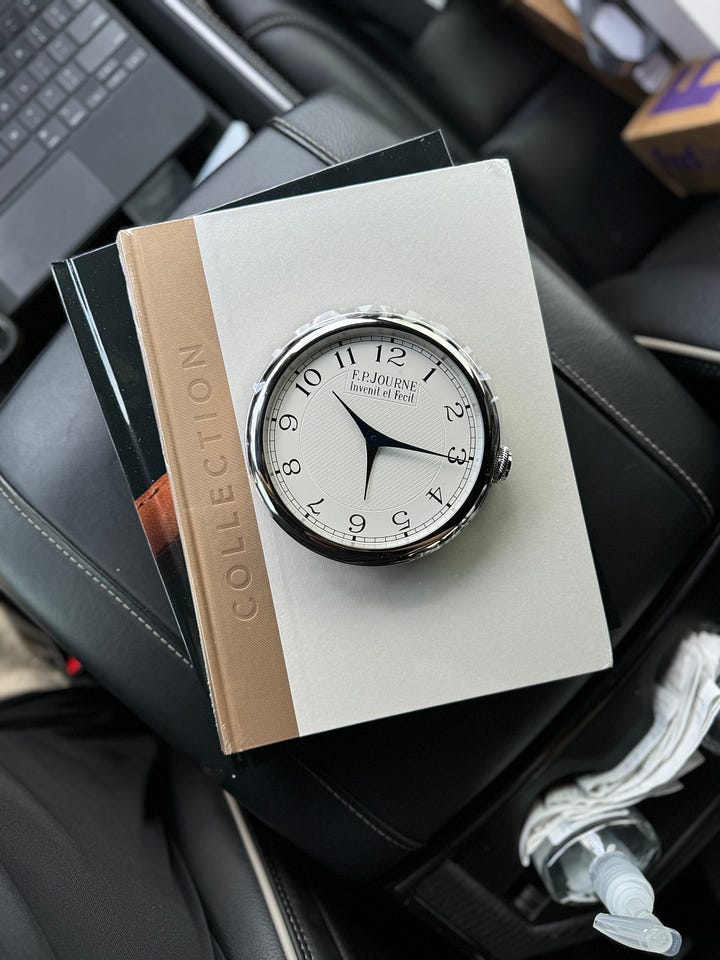
Nowadays, some fancy brands still make alarm clocks—sometimes they’re readily available, other times reserved for VIPs/VICs.
One collector sent me a few photos of his modern alarm clocks, adding this:
“Funny enough, I do use the Journe alarm clock. Not at home, but when I travel. I weirdly love travel clocks, something unique and old school about them.”
Cartier, Audemars Piguet, and others also have alarm clocks. Typically quartz, often mimicking well-known wristwatches. Some are better than others—at worst, they can make your home feel a bit too much like a boutique.
Generally, I want a little more character. These feel like brand-first propositions, while I prefer something more design-driven.
8/ Nanu Arc: The Best of Mechanical + Digital
Finally, we get to the alarm clock I’ve been using for the past 6 months: The Nanu Arc Alarm Clock.
“Time made tangible,” is Nanu’s tagline, and it’s brilliant.
This is an analog alarm clock (it plugs in and has a battery backup), but features a mechanical, acoustic chime. Inside is a chime bar, a percussive instrument that produces a gentle chime that gradually grows louder and faster to wake you up. Listen:
Much better than most mechanical chimes. Its cast metal housing weighs about 2 pounds, so it feels substantial. It’s clean and minimal, bordering on plain.
Nanu’s alarm clock is one of the most successful products I’ve seen at bridging the gap between digital and mechanical, using the best features of both. Those old mechanical alarms are jarring or altogether unpleasant ways to wake up. Nanu has improved upon those, producing a pleasant mechanical chime that’s better than most digital alarms.
It’s not quite a rooster, but there’s just something about waking up to a real, physical sound that feels better. Nanu Arc Alarm Clock ($235)
Let me know if you’ve got a cool alarm clock that’s better than an iPhone!
Watch of the Week: An Omega Railmaster (in 36mm!)
Omega Railmaster ref. 2504.52
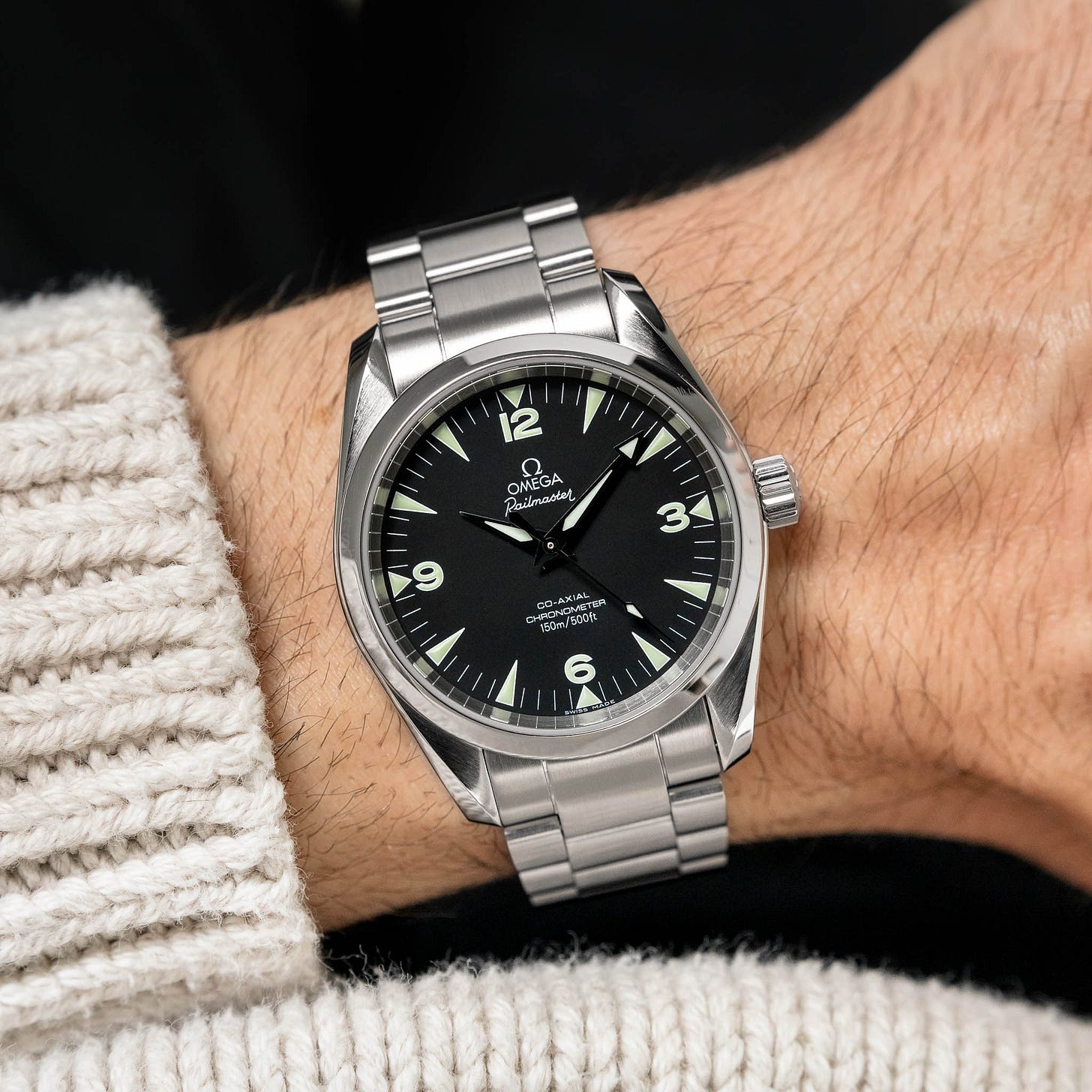
So Omega released a new Aqua Terra Railmaster. It’s fine. Basically a 38mm Aqua Terra with a “Railmaster” dial.
But it reminded me of this cult-favorite Railmaster from the 2000s, when Omega released a range of Railmasters from 36mm to 49mm (!). The 36mm ref. 2504.52 has become elusive for collectors. As the only modern Railmaster in the traditional 36mm, it’s tough to track down.
Chicago dealer Evan Jarzynski (Ticking Time Homme) put it on my radar a while back, and he said it’s the most asked-for watch on his site. A few weeks ago, Subdial listed one on for ~$7,200—it sold fast.
That 2000s slate of Railmasters is a reminder: It’s not merely that we need smaller watches, it’s that we need more size options. While brands offer their milquetoast watches like the Aqua Terra or Oyster Perpetual in a range of diameters, too many sports watches are offered in one size and one size only, based on the assumption that they could only possibly appeal to one type of person.
Have a good holiday weekend here in the States—this post is a bit different, so hit the heart or let me know if you liked it (or not, I guess)–Tony







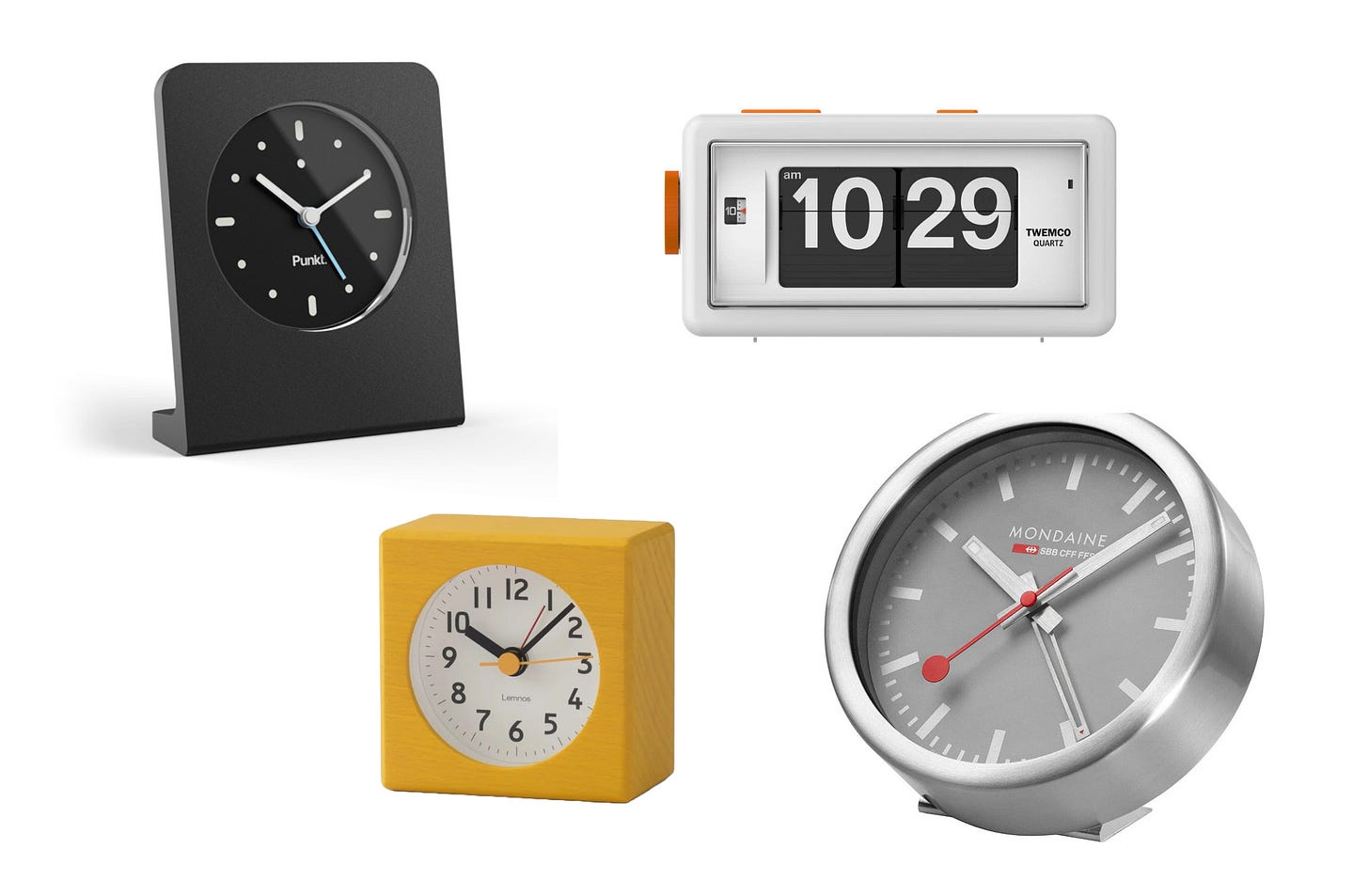

Top of the heap in my opinion is the Angelus mid-20th century range of desktop and travel clocks, often with a travel or aviation theme. Often found with Tiffany dial.
I have the Multitime from 1948, an 8-day moonphase calendar alarm clock, sharing a folding leather case with a revolving arctic-view depiction of the globe.
Great Piece on Alarm Clocks. My Lego Darth Vader alarm clock wakes me up with an increasing buzzing sound, but the Nanu Arc sounds like a great alternative ( Must Admit, Hard to Give up the Dark Side, though)